
‘No safe place’: Lead poisoning in the Dominican Republic
Elizabeth Mota is rarely able to see the sunrise when she wakes up in the morning.
The 48-year-old lives on the outskirts of the Dominican Republic’s industrial zone in Bajos de Haina, an impoverished port city in the San Cristobal province, just south of the capital Santo Domingo.
With at least 100 companies operating in this zone and two industrial parks, this area serves as the main industrial hub for the country.
The release of toxic smoke from the dozens of factories is ever-present in the lives of residents living near the industrial zone.
“When you wake up in the morning it still looks cloudy. But it’s actually just smoke from the factories,” says Mota, leaning on the side of her small, yellow house in the neighbourhood of Los Desamparados, meaning “the Forsaken”. “This contamination is killing us here. The more the factories grow, the more we become sick.”
Mota’s home is partially encircled by these factories, which are located behind cement walls abutting the roads. The zone resembles a shopping mall, with factory names and logos painted onto the plain cement walls representing chemical, pharmaceutical, metallurgical and other industries.
In 2006, Haina was found to be the third most toxic site in the world and it was once called the “Dominican Chernobyl”.
Anyone who could afford to leave the city did so long ago. Those who remain are the poorest of residents who cannot afford to relocate.
Skin lesions, respiratory problems, and a myriad of other health issues have become the norm for people living here. Mota suffers from respiratory issues and her teenage daughter has asthma and skin lesions that flare up into blisters when the smoke in the area becomes too dense. But one of the biggest concerns for the nearly 160,000 city residents is lead poisoning, which causes breathing and skin issues, and is believed to have led to severe neurological damage in children.
Mota, along with five other residents of Los Desamparados, tested positive in 2019 for lead poisoning – which residents allege is being caused by Verde Eco Recycling Industrial (VERI), an automobile battery recycling plant - a claim which the company vehemently denies. VERI says it operates under strict environmental standards and does not generate any contamination, smoke, or lead poisoning.
For decades, residents of Haina, including Mota, have led protest movements calling for the closure of these factories, but to little effect. “If I could wake up in the morning and see the sky, I would feel much better,” she says.
The factories contaminate every aspect of their lives, says Mota. “We are tired of it. We want to see parks and cultural centres - things that bring positivity to the people of Haina. These factories bring us nothing but misery.”
 Haina, like much of the country, was rural before the sugar mill arrived
in the 1950s followed by other factories. Today, boys play baseball
beside massive tanks storing chemicals
Haina, like much of the country, was rural before the sugar mill arrived
in the 1950s followed by other factories. Today, boys play baseball
beside massive tanks storing chemicals
On a small field near the centre of Haina, a group of boys practising baseball laugh and race one another. Massive containers that residents allege store chemicals to manufacture products like paint and plastic tower above them. These containers belong to Multiquimica, a chemical production and storage company. Multiquimica did not reply to Al Jazeera’s request for comment about what is being stored in these containers near residents and allegations that the contents are dangerous.
Down the street are more massive tanks. Residents do not know who owns them or what is being stored in them, but call the containers “los tanques de la muerte”, or “the death tanks”.
Like much of the country, Haina was rural and sparsely populated until the early 1950s, when the country’s dictator Rafael Trujillo, in power from 1930 until 1961, established what was then one of the world’s largest sugar mills here – marking the beginning of the city’s industrialisation.
Haina attracted Dominicans from all over the country who arrived to access employment from the government-owned sugar mill while mixing and sharing their cultures.
Scores of Haitians, meanwhile, also arrived from western Hispaniola, the Caribbean island both countries share, to cut sugarcane on the plantations, bringing their music and dance with them.
Haina, along with the larger San Cristobal province, would become part of the cradle of Afro-Dominican culture, according to Segundo Maldonado Abreu, 62, a local historian and director of Casa De La Cultura De Haina, a local cultural centre.
Gaga street celebrations, which occur in spring during Easter week to commemorate the fertilisation of the earth, arrived in the Dominican Republic with Haitian sugarcane cutters, and spread throughout the Dominican countryside. Haina was an epicentre for these festivities.
“Haina was like a big field,” says Abreu, who is among a shrinking number of people who remember life before the factories. “People used to eat fruit from the trees all day. When we’d come home each day in the evening, we were already full from the fruit. We used to swim in all the rivers.”
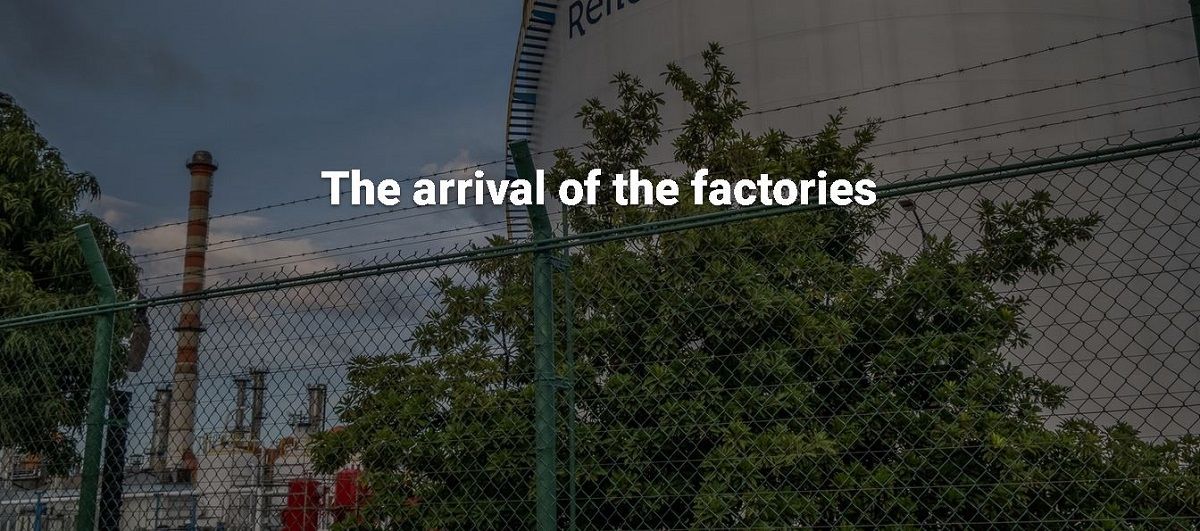 Residents say the widespread contamination started after the country’s
sole oil refinery Refidomsa was established in Haina in 1973
Residents say the widespread contamination started after the country’s
sole oil refinery Refidomsa was established in Haina in 1973
According to residents, the widespread contamination of the land and rivers began in 1973 when the country’s sole oil refinery Refidomsa was established in Haina, and more companies started arriving in the area, forming the industrial zone.
The city was transformed into the manufacturing powerhouse of the country, gobbling up energy from the people of Haina and operating with little to no environmental regulations.
“The factories came here and hired the people in Haina,” says Mariano German De La Cruz, 52, a local activist. “They overworked the people. The companies earned their money and then they left the people sick and tired and without any money.”
Valerio German, 58, was a teenager when the industrial zone was established and his family has lived in Haina for five generations. “I remember when everyone started moving here,” says German, who lives next door to Mota. “Everyone came looking for jobs. But no one would ever want to live here now. People only leave this place.”
The rivers and lakes that crisscross Haina before meeting the Caribbean Sea are now littered with plastic and rubbish. When it rains, waste on the streets in the capital gets funnelled into the low-lying Haina River.
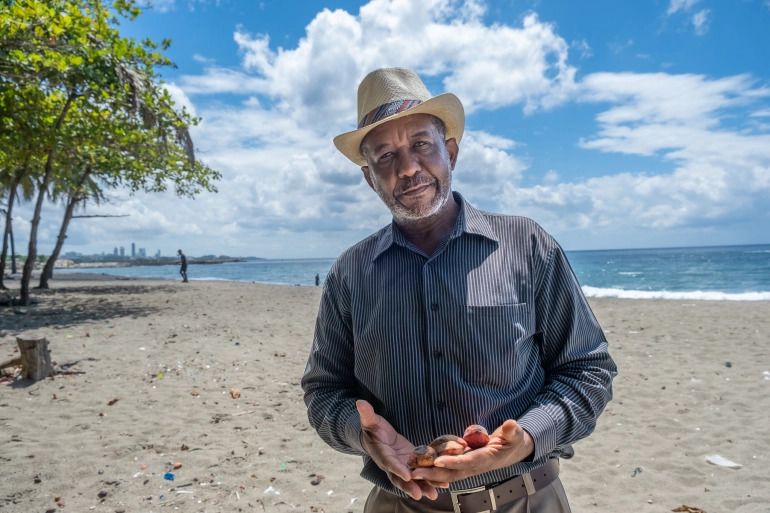 Local historian Segundo Maldonado Abreu, at Los Gringos beach, says
Haina was like a big field where people ate fruit from the trees before
the factories arrived
Local historian Segundo Maldonado Abreu, at Los Gringos beach, says
Haina was like a big field where people ate fruit from the trees before
the factories arrived
The fruits that once filled children’s bellies are no longer able to grow there, and industrialisation has stripped the neighbourhoods of any potential value, condemning residents to intergenerational poverty.
“Our house has been in this family for generations,” German says. But now it is completely worthless. “No one with a sane mind would ever buy a house in this area.”
Along the outskirts of the industrial zone sit abandoned homes, some of them large villas, which their owners left when they fled the contamination. Owing to their location, it was impossible to sell them.
Those born after the establishment of the industrial zone know no other life except one in which factories continuously grow.
Residents have become so used to the presence of smoke and gas emanating from the factories and wafting through their neighbourhoods that they can determine which company is polluting depending on the odour, colour, and how the smoke affects them.
“They all smell different,” De La Cruz says. “And the colours are different – the smoke from VERI is white, another is black, another is dark blue, and another has a pinkish tint. We can also tell by the way it affects us - for instance, one kind of smoke will make our eyes and nose burn, another one will make them itch.”
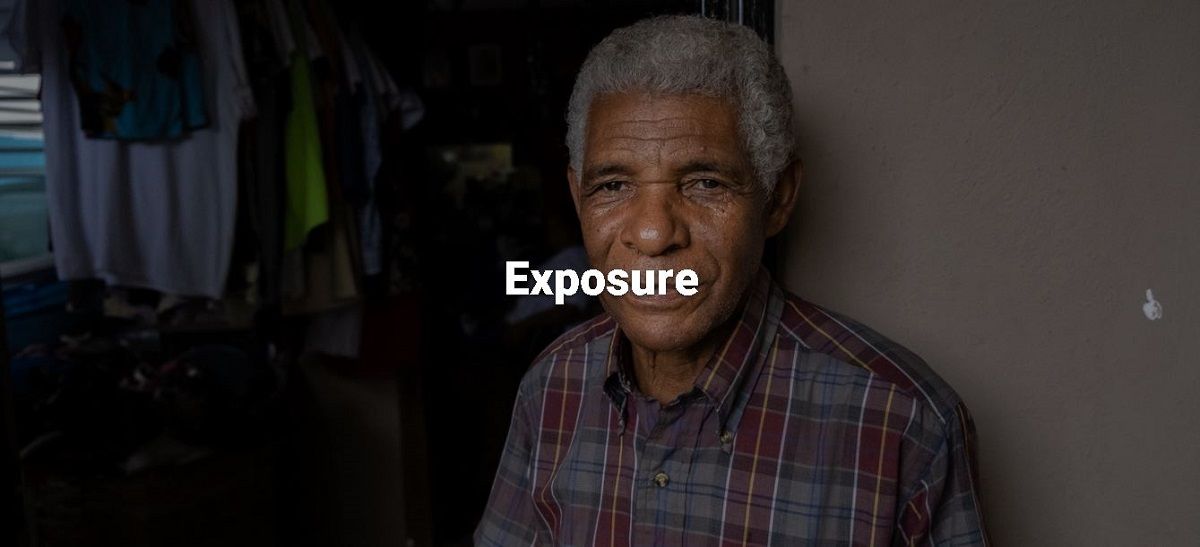 Rafael Antonio Hernandez, 73, a resident of Paraiso de Dios, says when smoke was released at night, “we couldn’t even breathe”
Rafael Antonio Hernandez, 73, a resident of Paraiso de Dios, says when smoke was released at night, “we couldn’t even breathe”
In 2000, the country’s Ministry of Environment and Natural Resources was established and environmental regulations that companies must abide by were created. Residents in Haina were for the first time provided an avenue to legally challenge what they say has been decades of factories polluting their communities.
Almost immediately, residents put together their small salaries and collected donations to take several of the companies that they say are still flouting environmental regulations to court.
Activists say the government continuously fails to enforce the regulations. “That’s a ministry for people with power and money,” Abreu says.
But in 2000, the seemingly impossible happened. Activists had been demanding the closure of a previous lead-acid battery recycling and manufacturing plant - and won.
In the neighbourhood of Paraiso de Dios, meaning “God’s paradise”, Industrias Meteoro, or Meteoro Industries, had operated the plant for decades.
According to Conrado Depratt, a professor in chemistry at the Universidad Autonoma de Santo Domingo (UASD), Meteoro’s factory disposed of waste from the batteries containing high amounts of lead directly into the soil, contaminating the ground and water.
The smoke released in the smelting process also contained lead, along with antimony – another toxic element that can cause damage to the heart, lungs, and stomach – and arsenic, and would spread with the wind, says Depratt.
Rafael Antonio Hernandez, 73, a resident of Paraiso de Dios and one of the key activists in the movement to close the factory, lives just down the street from the former plant.
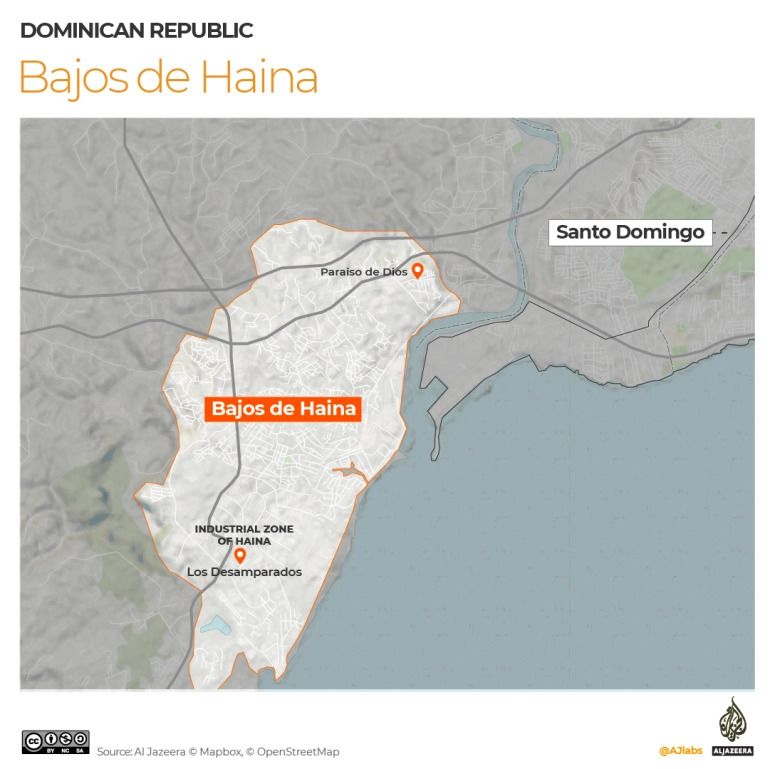
He recalls how smoke would be released each night. “We couldn’t even breathe,” he says. “I remember putting a large tank outside when it rained to collect the water [for washing and cleaning], and in the morning the entire bottom of the tank would be filled with residue from the plant. It looked like black acid.”
Even during the day, the smoke would force residents to spend most of their days indoors with the windows closed.
Adults and children developed various health issues, including skin itching and lesions, problems with breathing, weakness, dizziness, and anaemia.
Children were the worst affected - they developed chronic breathing issues, irreparable neurological damage resulting in severe developmental disabilities, stunted growth, and experienced serious learning difficulties.
Henry Butler, the general manager of VERI, which is also partly owned by Meteoro, did not deny the contamination allegations, saying that the issues in Paraiso de Dios were clearly documented, “current technology was not available back then,” and “people settled without official control next to a lead smelting factory.” But he notes that Meteoro does not have “any knowledge, or record, of individuals with health issues related to lead contamination.”
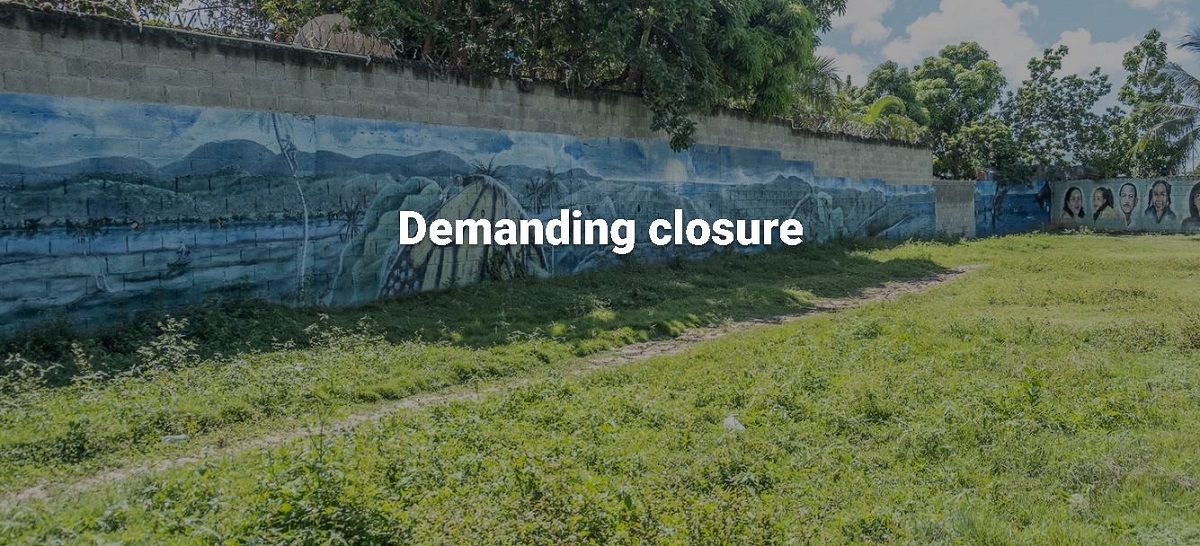 After a sustained protest by the community of Paraiso de Dios, a
lead-acid battery recycling plant was ordered to close in 2000 and the
former grounds were turned into a park that was decorated with images of
local activists and children affected by the lead
After a sustained protest by the community of Paraiso de Dios, a
lead-acid battery recycling plant was ordered to close in 2000 and the
former grounds were turned into a park that was decorated with images of
local activists and children affected by the lead
Residents of Paraiso de Dios led a sustained protest movement demanding the closure of the factory, which included prolonged demonstrations outside the plant grounds.
In the late 1990s, Depratt, along with other UASD professors, partnered with experts from the New York City-based non-profit Friends of Lead Free Children to test 146 children in Paraiso de Dios for lead exposure and found dangerously high levels in their blood.
According to Blacksmith Institute, now called Pure Earth, a United States-based non-profit organisation working on mitigating global pollution issues, at least 28 percent of children in Haina required immediate treatment for lead exposure, while 5 percent were at risk of neurological damage due to their blood lead levels.
Blood lead levels of more than 10 micrograms per decilitre (10µg/dl) are universally accepted as the low-level lead exposure threshold. Some of the children tested in Paraiso de Dios showed levels as high as 211µg/dl, according to data from UASD.
“The doctors could not understand how some of these people were still alive,” Depratt says.
The findings led the Ministry of Environment and Natural Resources to order the closure of the plant in 2000, following heightened international media attention – staining the Dominican Republic’s reputation as a safe destination for millions of foreign tourists each year.
But after the factory was closed, the soil was flipped to cover the site, leading to more lead exposure.
“This brought up layers of lead which had accumulated over the years. Every time it rained in the village, the soil from the hill site ran through every street and some homes, leaving lead behind,” says Steven Null, director of Friends of Lead Free Children.
Lead dust would get kicked up by cars or children playing outdoors.
From 2008 to 2009, two years after Haina was found to be one of the most toxic places in the world, UASD, Friends of Lead Free Children and other organisations carried out wide-scale environmental remediation initiatives.
More than 6,000 cubic metres (1.6 million gallons) of lead-contaminated material was removed from the site while neighbourhood walkways and backyards were also excavated and backfilled with clean sand and soil.
“When [the factory] finally closed [and the cleanup commenced], we all felt like we were given a new life,” Hernandez says, smiling. “Soon after, the trees began growing back. Now when we plant a flower in the ground, it will grow. We started spending our time outside. We felt very happy. The owners were these rich people who had a lot of strong ties to the government. The reality was set up for us to fail. But we did the impossible.”
 Residents of Paraiso de Dios believe the community still deserves
compensation for the effects of the lead, particularly on the health of
children
Residents of Paraiso de Dios believe the community still deserves
compensation for the effects of the lead, particularly on the health of
children
On a humid day in August last year, the sunshine spilled through the blue, clear skies and past the surrounding palm trees, illuminating the murals of a park. It is a rare green haven in Haina amid a concrete ocean, a flickering glimpse into another world the communities have long dreamed about.
After the clean-up, the neighbourhood decided that the site of the old factory should be transformed into an ecological park. Residents decorated the walls once marking the premises of the toxic plant with portraits of local activists who led the struggle against the company, faces of children who were affected by the lead, and symbols of the local natural environment – palm trees, the sea, and dolphins.
The community had hoped to receive funding from Meteoro or the government to do more with the space, but have not. With a lack of funds, they have only been able to develop the park into an open green space with a small area to play basketball.
At the park, Al Jazeera met a man in his mid-to-late 20s who was severely affected by lead poisoning and suffered brain damage as a child. He smiled in greeting but was unable to follow the conversation.
“We deserve compensation,” Hernandez says. “They should have to pay for the suffering they caused here and for the people who are still living with the effects of this lead. But these companies never have to face any consequences for what they do to us.”
Following years of treatment, many of those suffering from lead poisoning were able to fully recover, Depratt says; however, some of the children who suffered neurological damage will never heal.
Residents in Paraiso de Dios tell Al Jazeera they are no longer concerned about lead poisoning. However, lead levels have not been monitored since 2010 in Paraiso de Dios or any other part of Haina, and residents say they continue to have serious health problems because of the factories.
Lead is stored in the bones for decades, according to Null, and affected pregnant women will release lead into breast milk, causing poisoning in nursing children, which can damage the child’s brain, kidneys, and nervous system, along with causing learning or behavioural problems later in life.
Viviana Criseliz Ogando, a doctor who runs a private clinic in Haina and who worked with those affected in Paraiso de Dios, says that she still often receives patients at her clinic exhibiting symptoms of lead poisoning. “I still see many people with breathing problems, muscle pains, and brain issues,” she says.
It costs about 1,800 Dominican pesos ($31) for a blood lead test, which is too expensive for most Haina residents. “I don’t do the blood tests because the costs are too high,” Ogando says. “So I give them medicine and vitamins to try and fight the symptoms. In the end, if they do have lead poisoning they would need to leave the community to get better, and they are too poor to do that.”
 After closing in Paraiso de Dios, Meteoro Industries opened the VERI
automobile battery plant recycling in a different part of Haina.
Residents nearby attribute their health problems to VERI and other
factories
After closing in Paraiso de Dios, Meteoro Industries opened the VERI
automobile battery plant recycling in a different part of Haina.
Residents nearby attribute their health problems to VERI and other
factories
But as Meteoro Industries shuttered its plant, the company had already begun moving their operations to the city’s industrial zone, near Los Desamparados and just down the street from where Mota and German reside.
The relocation happened almost immediately, says De La Cruz who lives in Los Desamparados and was also involved in the protest movement in Paraiso de Dios. Several years after operations began, the neighbourhood began to connect the dots.
Residents began noticing changes in the environment. The trees changed colour and the vegetation around their homes began withering up and dying.
This was accompanied by “a horrible gas that would make it so people could not breathe,” De La Cruz says. Local activists began to research the origins of the factory operating with no name on the gate. Through documents they obtained from the town hall in 2011, they discovered the operations were owned by the same company that had polluted Paraiso de Dios.
 The conveyor belt part of the VERI plant which crushes recycled batteries
The conveyor belt part of the VERI plant which crushes recycled batteries
“We started to protest outside the company, and soon after that they [the factory] changed their name to VERI,” De La Cruz says.
Butler says that Meteoro Industries opened a new recycling plant in 2011 under the name Meteoro Recycling.
According to a 2020 environmental audit conducted by the Ministry of Environment and Natural Resources, Meteoro Industries requested to change the plant’s name in 2012 to VERI and a sign went up outside. Community members believe the name change was requested so that the company could distance itself from the lead poisoning controversy in Paraiso de Dios.
On its website, the company claims to be “100% green”.
The factory entrance gate has bold green letters saying: “Take care of the planet. Recycle your batteries” inside green cyclical arrows, the universal recycling symbol.
According to VERI’s Butler, who says the company is a local Dominican entity, the plant “does not send contaminants into the environment in either solid, liquid or gas form”.
Butler tells Al Jazeera that VERI operates under “strict environmental standards” and in accordance with the guidelines of the Basel Convention international standards for the disposal of hazardous wastes.
 Elizabeth Mota, along with five other residents of the Haina
neighbourhood of Los Desamparados, tested positive in 2019 for lead
poisoning
Elizabeth Mota, along with five other residents of the Haina
neighbourhood of Los Desamparados, tested positive in 2019 for lead
poisoning
But residents around Los Desamparados tell Al Jazeera a very different story.
Thick, white smoke is released from VERI’s factory at least a few times a month, they say, usually during the night or early in the morning, or when it is raining – and at times during the day.
Al Jazeera did not witness any emissions being released from VERI’s factory during its visits to the neighbourhood but, even without the smoke, this reporter’s eyes and lips began burning; itchy skin rashes, along with a sore throat and cough developed after about 30 minutes of conducting interviews around the factory.
Butler says “no ‘smoke’ comes out of the tower, just warm air”.
German says that his father, who died at 86 in 2018, developed severe breathing issues soon after VERI began its operations. “My father had to stay in the house all day because he couldn’t handle the gas,” German says. “He would just be talking normally and suddenly he would start choking, like he was suffocating and couldn’t breathe. And this is what eventually killed him.”
German’s father also began experiencing convulsions and seizures, which are symptoms of severe lead poisoning. German himself has been gripped with seizures several times.
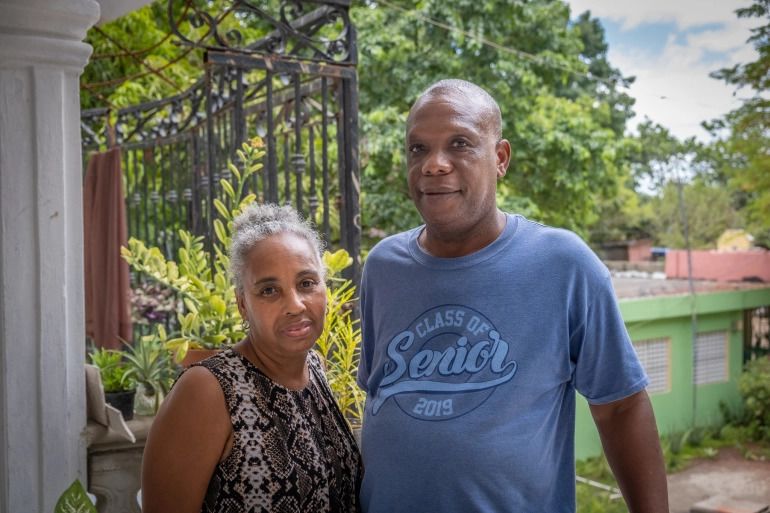 Valerio German, with his wife at their home, says his father developed
breathing problems and seizures after VERI began its operations
Valerio German, with his wife at their home, says his father developed
breathing problems and seizures after VERI began its operations
In 2018, Haina activists hired Mirsa, a Dominican environmental consulting company to investigate the alleged contamination. The company took samples of the air quality and soil around the VERI factory and found dangerously high levels of lead and chromium, a highly toxic substance linked to respiratory cancers and skin irritation, along with organ and permanent eye damage.
Butler says that Mirsa had “lied” in their report and that the company has a “poor reputation”, adding that VERI has since taken legal action against Mirsa. Alexander Rodriquez, operations manager at Mirsa, strongly denied these allegations to Al Jazeera. He noted that the company solely collected the samples, processed in the US, and presented the results in the report.
Mirsa’s report was also used by residents in Haina to bring VERI to court in 2018, demanding the closure of the factory.
Rodriquez confirmed that VERI had sued Mirsa, but says the courts ruled in Mirsa’s favor and Mirsa has since responded by suing VERI for damages.
Butler sent Al Jazeera a 2019 report detailing a study by Instituto Tecnologico de Santo Domingo, a private university in the capital, which was carried out at the behest of VERI. The report shows that air samples taken around the factory contained levels of lead within the accepted limits.
In 2019, residents of Los Desamparados were able to collect enough funds to take blood samples from 12 people living around the VERI factory. The results, which were seen by Al Jazeera, showed six tested positive for lead poisoning, with four having levels as high as 65µg/dl.
They have taken their findings to the Dominican government. But for more than two years, nothing has been done about the lead poisoning, according to residents, including any comprehensive investigation by the government.
“The ‘alleged community groups’ [waging the court battle] are part of a ‘fake news’ campaign” funded by illegal competitors wanting to discredit the company, Butler says.
The Ministry of Environment and Natural Resources declined to comment on the matter, saying it could not comment because of the ongoing court case.
In its 2020 environmental audit, the ministry found one serious environment-related non-compliance at the VERI plant, which involved contaminated run-off rainwater from the factory grounds.
Butler sent Al Jazeera a 2020 official letter from the Ministry of Public Health that states there is no evidence of health damage among people allegedly exposed to lead in Haina.
However, Al Jazeera spoke with almost two dozen residents in Haina who reported serious health problems that they attribute to VERI, along with other companies they say are contributing to the contamination.
 Activist Mariano German De La Cruz's 13-year-old son, José, tested positive for lead poisoning
Activist Mariano German De La Cruz's 13-year-old son, José, tested positive for lead poisoning
De La Cruz says after decades of isolated struggles, activists have united all the neighbourhoods “to take on all of these factories together”.
In August, a bus packed with people from around the city arrived to support Los Desamparados’ struggle against the VERI factory.
Dozens of protesters blocked the main road used by the trucks coming in and out of the industrial zone before marching towards VERI’s entrance, chanting protest slogans against the contamination.
One of those who tested positive for lead poisoning was De La Cruz’s 13-year-old son Jose. “It was a huge shock for me,” says De La Cruz. “It’s very scary because it brought back all the memories from the children in Paraíso de Dios and the brain damage and growth problems they suffered.”
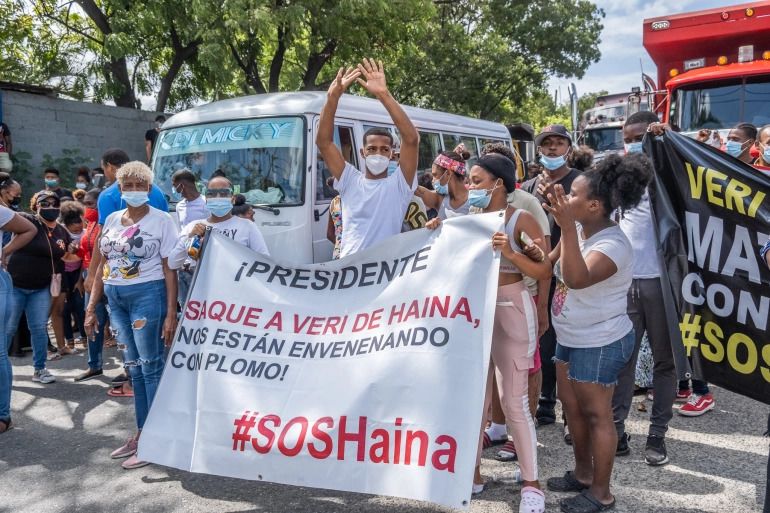 In August 2021, different Haina neighbourhoods came together to protest and support Los Desamparados’ struggle against VERI
In August 2021, different Haina neighbourhoods came together to protest and support Los Desamparados’ struggle against VERI
His wife, Maria, 37, says she is giving Jose vitamins to treat the symptoms, which mainly consists of painful headaches and difficulty breathing, but is at a loss as to what more she can do.
“There’s no safe place in Haina,” she says with frustration, shrugging her shoulders. “The smoke from VERI goes everywhere, so the lead is everywhere, too. So wherever he goes he’s in danger.”
Jose, speaking in the presence of his parents, says the lead comes with the smoke at night and when it does, the headaches and breathing problems return.
Jose says he felt scared when he tested positive. “I’m scared of death,” he says, shyly twiddling his small thumbs. “I’m scared that it [lead] will kill me.”
Maireni Florentino, 28, sits on the porch of her small home with her arms wrapped around her child sitting peacefully on her lap. She lives just a few hundred metres from the VERI factory. Behind her house is a large factory that manufactures super glue.
Florentino, a mother of three young children, also tested positive for lead poisoning. She moved near the industrial zone several years ago because she could not afford to live anywhere else.
“I felt very angry when I learned I tested positive,” she says. She cannot afford to get her children tested but she assumes that they must be positive too.
When she sees the smoke, they go indoors. “Even when the windows are closed we can still feel it inside.”
 Engrid Rodriquez, who stands with one of her sons, says she developed
painful breathing problems a year ago which make her feel like she is
drowning. Her family lives on the outskirts of the industrial zone, near
VERI
Engrid Rodriquez, who stands with one of her sons, says she developed
painful breathing problems a year ago which make her feel like she is
drowning. Her family lives on the outskirts of the industrial zone, near
VERI
Almost everyone Al Jazeera spoke to in Haina recounted stories of relatives’ deaths, blaming the toxins released from the factories.
Florentino says that about two years ago, her nine-month-old nephew died after a severe skin reaction that developed into boils.
Miguelina Cabrera, 43, lives about 500 metres away from VERI. She tested negative for lead poisoning but says her 68-year-old mother died from a respiratory condition.
“All this contamination affected her lungs,” she says softly, standing outside her home. “They became like rocks and she wasn’t able to breathe any more.”
She never smoked, she adds. “The doctors tell us it was because of the contamination.”
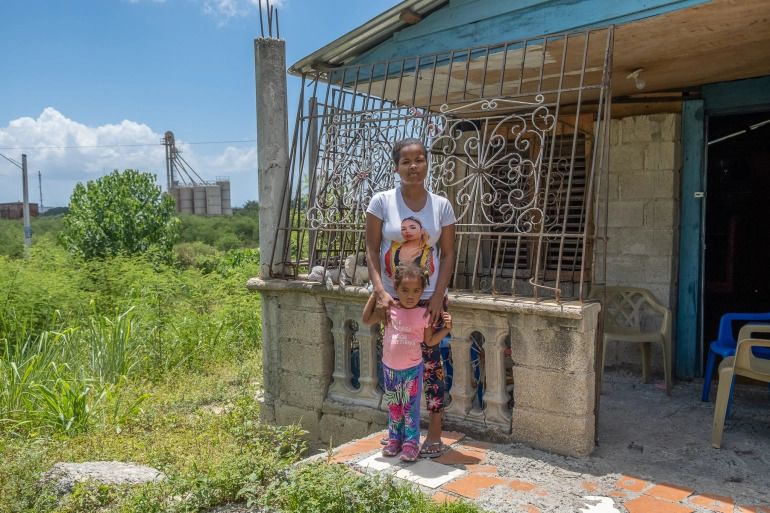 Maireni Florentino, a mother of three young children, says she felt
angry when she learnt she tested positive for lead poisoning
Maireni Florentino, a mother of three young children, says she felt
angry when she learnt she tested positive for lead poisoning
Engrid Rodriquez, 39, began to develop breathing problems about a year ago, when she lost her job as a housekeeper for a family in the capital, causing her to spend most of her days at home and closer to the fumes.
“If I breathe deeply it creates a lot of pain in my chest,” she says. “It feels like I’m drowning.”
 Santa Frias stands near her small shop in the industrial zone. Frias
along with two of her children tested positive for lead poisoning
Santa Frias stands near her small shop in the industrial zone. Frias
along with two of her children tested positive for lead poisoning
Santa Frias, 34, and two of her three children, tested positive for lead poisoning. She lives near the VERI factory and since the COVID-19 pandemic, she has served coffee and breakfast to workers from a small shop inside the industrial zone, directly adjacent to VERI.
Her children who tested positive for lead are 11 and 18-years-old. Her youngest child suffers from severe chest pains and breathing problems, Frias says, and both children have been forced to miss school owing to periodic fevers.
While she is worried about her children’s health, she has no choice but to stay. “I don’t have anywhere else to go,” Frias says.
 Marta German says residents live not only with contamination but constant fear that the factories will catch fire and explode
Marta German says residents live not only with contamination but constant fear that the factories will catch fire and explode
The contamination and health issues are not the only concerns for people across Haina.
Residents live with the constant fear of one of these factories exploding. Living near Refidomsa, the oil refinery, which transports oil through a network of massive pipes built underneath them, the fear of the refinery catching fire keeps some residents up at night.
“If that oil refinery ever caught fire all of Haina would explode,” says Marta German, 53, who lives near the city centre. “I think about this every day when I wake up. We just pray to God that the people running these factories know what they are doing.”
This fear does not come from paranoia; the factories have caught fire before – and it is not uncommon for it to happen a few times a year.
Multiquimica, the company storing and providing raw chemicals, caught fire about nine months ago and VERI had caught fire about a week before Al Jazeera’s visit in August.
Multiquimica’s fire happened at night and many residents assumed their worst nightmare was becoming reality. Firefighters woke everyone up and told them to flee to a safe place. With only factories around, many did not know where to go or what to do.
“Everyone ran out of their homes and into the streets,” Marta says. “Even people were running in the streets naked. They just fled their homes and ran around frantically, like crazy people. We all thought that at any moment the factory was going to explode and kill all of us.”
She also ran outside with her children and small grandchildren. They held hands, prayed and told each other how much they loved one another. “We were waiting for the worst to happen,” she says.
“We have to live with this constant fear,” Marta adds. “But somehow people get used to it here. Our lives are always in danger in Haina. Life here is always in suspense. The worst could happen at any moment. But I don’t have the resources to leave this place, so most of us have just accepted our fate here.”
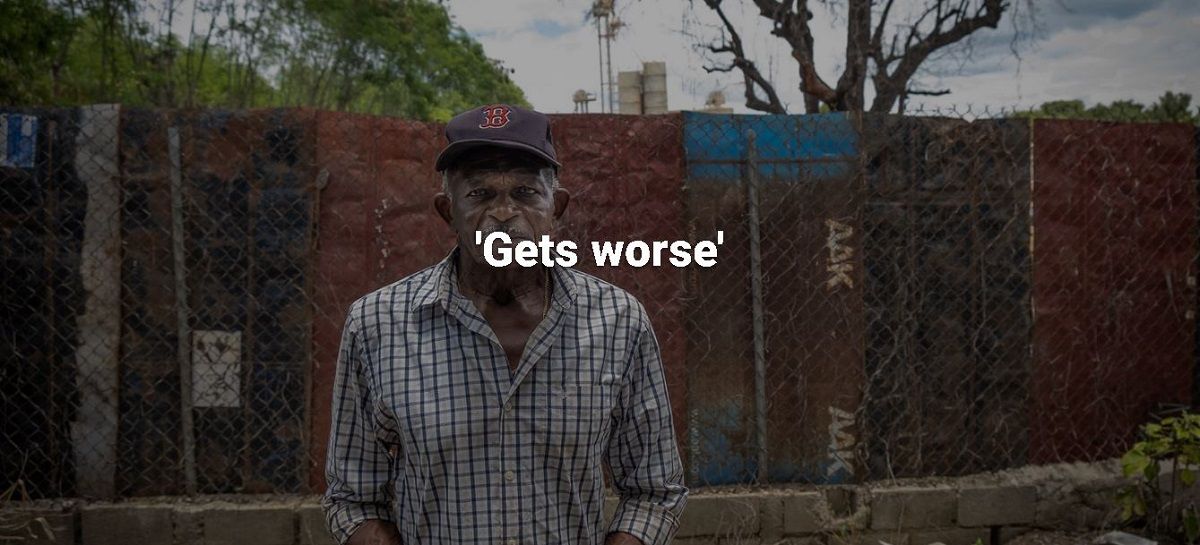 Ramon German, 81, stands in front of the stinking, fly-ridden area used
for dumping rotting fruit. He says the contamination in Haina only ever
gets worse
Ramon German, 81, stands in front of the stinking, fly-ridden area used
for dumping rotting fruit. He says the contamination in Haina only ever
gets worse
There is nowhere you can go in Haina where people are not affected by the contamination.
A short trip to a colmado, or local convenience store, results in the shop owner lifting up his pant leg to show a skin lesion above his ankle. “It comes and goes”, says Hilario Fulgencio Azo, 45, explaining that the lesion flares up when the air pollution is bad, his voice rising as Dominican bachata music blares from the shop’s speakers.
Azo says the already impoverished city residents have to buy bottled water each day owing to the assumed contamination of the local water. In the poorest areas, some residents are forced to drink contaminated water.
“Even if someone in Haina had money, there’s nothing to invest in. So throughout all the generations, we don’t have any option but to work for these same factories that are killing us,” he says.
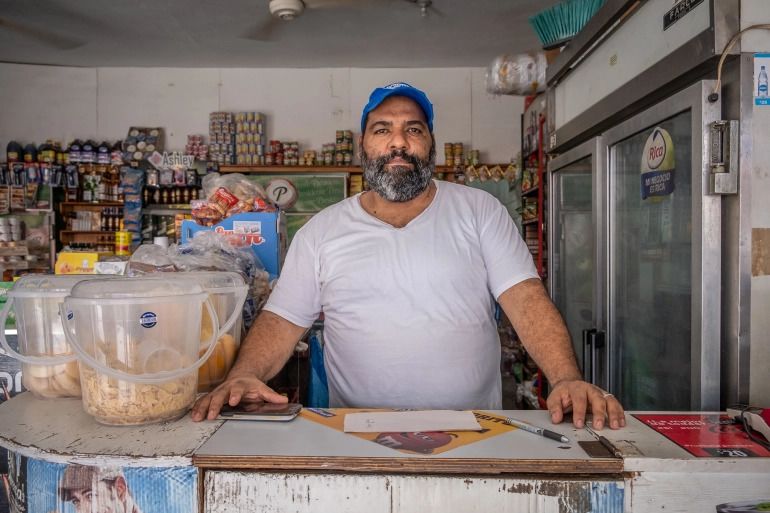 Hilario Fulgencio Azo at his colmado in Haina says already impoverished residents are forced to buy bottled water
Hilario Fulgencio Azo at his colmado in Haina says already impoverished residents are forced to buy bottled water
Medical bills also pile up.
Elizabeth Peguero, 32, was born and raised around the industrial zone. Her house is located across the street from United Petroleum, a gas company, and beside Pegatod Cementin, which manufactures construction supplies, such as dry or melted mortar.
She says smoke from Pegatod Cementin’s manufacturing causes her nine and six-year-old to suffer chest pains and pneumonia, common ailments in the city, and she is forced to take them to the hospital and to the doctors once a month. Pegatod Cementin did not reply to Al Jazeera’s request for comment about the alleged health effects caused by its manufacturing process.
Peguero’s medical bills cost about $50 every six months. She works as a housecleaner and her husband sells fuel at the local market. To afford these medical costs the family often has to cut down on food.
 Those who could, fled the contamination in Haina, which ranges from lead poisoning to rubbish-filled lakes, a long time ago
Those who could, fled the contamination in Haina, which ranges from lead poisoning to rubbish-filled lakes, a long time ago
There is also black smoke that overtakes the neighbourhood from a large area used by the town hall to burn trash near the industrial zone. “All the people suffering from breathing problems here have to go to the hospital when town hall burns the trash. The hospitals become full with people,” Peguero says.
Ramon German, 81, has lived near the industrial zone for more than 60 years and thought he had seen it all. But about 10 years ago a large area directly across the street from his home was converted into a facility for dumping rotting fruit; residents suspect it is being used by a juice manufacturing company.
“The smell is insufferable here and all the houses have hundreds of flies inside them,” he complains, swatting a fly from his face.
“Maybe in a few years when they open up more factories we’ll miss the days when we only had lead poisoning. Every year gets worse and worse,” says Ramon, who has spent his life’s savings to fix his windows and rebuild the roof of his home to protect against lead emissions. “Everyone is very scared of this lead.”
Luisa Baleria German, 59, says that every day she notices a new contaminant or nuisance to the community. Recently, rubbish bags started falling onto the streets from trucks heading to a recycling storage facility in Los Desamparados.
“Nothing will ever change here,” she says. “The government here doesn’t care about poor people. We have taken videos and documents to the government proving what these companies are doing to us here. But they just ignore it. No one ever does anything about it. I don’t think the government will ever wake up to the fact that the people of Haina are worthy of life. We have no choice but to just wait here for death.”
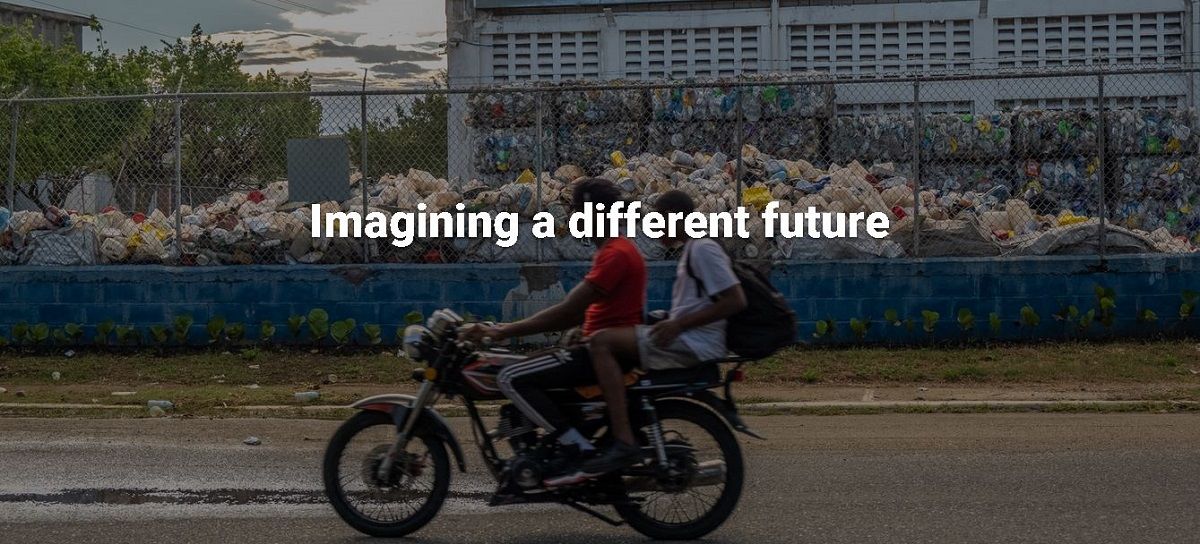 Community leaders are trying to help a younger generation, who have
known contamination their whole lives, imagine a different future by
teaching them about the environment and their rich cultural heritage
Community leaders are trying to help a younger generation, who have
known contamination their whole lives, imagine a different future by
teaching them about the environment and their rich cultural heritage
But since the movement in Paraiso de Dios two decades ago, activists in Haina have been working to convince people that they deserve more than contamination.
Movimiento Pensamiento Transformador de Haina, or Haina’s transformative thought movement, is a small group of activists who refer to themselves as “transformers” and are attempting to utilise the city’s unique culture and history to encourage the youth in particular, who have known contamination all their lives, to imagine a different future.
“Haina is not only contaminated,” says Abreu, who is a transformer. “It’s a community that wakes up every day, looking for a better way to live.”
Neighbourhoods in Haina are tight-knit communities and despite the pollution around them, residents are constantly laughing and joking with one another.
“We all help each other out. We share food and stories. We’re like a big family,” says Tomasina Palanco, 49, a resident.
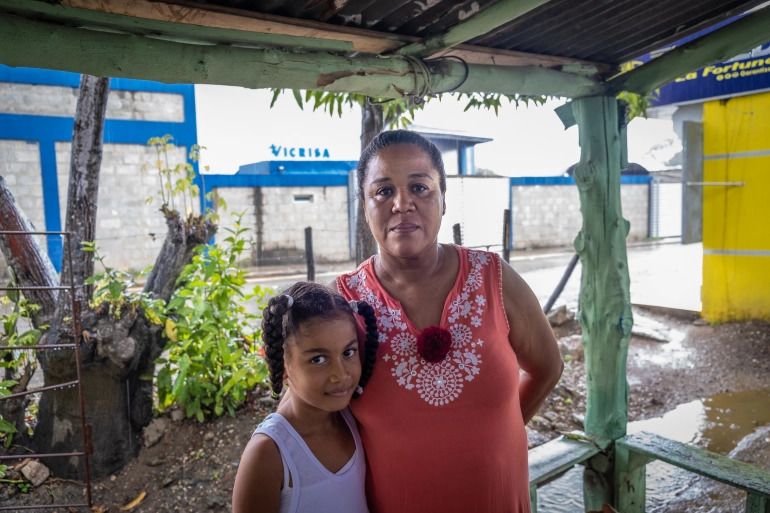 Tomasina Palanco stands with her granddaughter in front of a company in
the industrial zone. Despite their struggles, people in Haina are like a
“big family”, she says
Tomasina Palanco stands with her granddaughter in front of a company in
the industrial zone. Despite their struggles, people in Haina are like a
“big family”, she says
“This contamination brings us closer together as a community because all of us are fighting for our lives,” says Fausto de Leon Castillo, the neighbourhood leader in Paraiso de Dios.
The movement hopes to unite the people of Haina beyond their suffering.
“The principal resource in Haina is the people,” says De La Cruz, who wears the wide-brimmed hat donned by transformers.
Factories need people, but Haina’s residents work all their “lives to make someone else rich and then they end up sick with nothing,” he says.
“People are too scared to even ask for better pay from these factories because they might lose their jobs and not be able to provide for their families," he says. No factory worker would speak to Al Jazeera for fear of facing reprisals at work.
“The people of Haina are special people and we’re trying to remind them of that. They are more than just a tool for a factory to make money,” De La Cruz says.
When people realise this, then they can demand that the government and factories “give back some of what they have taken from us”.
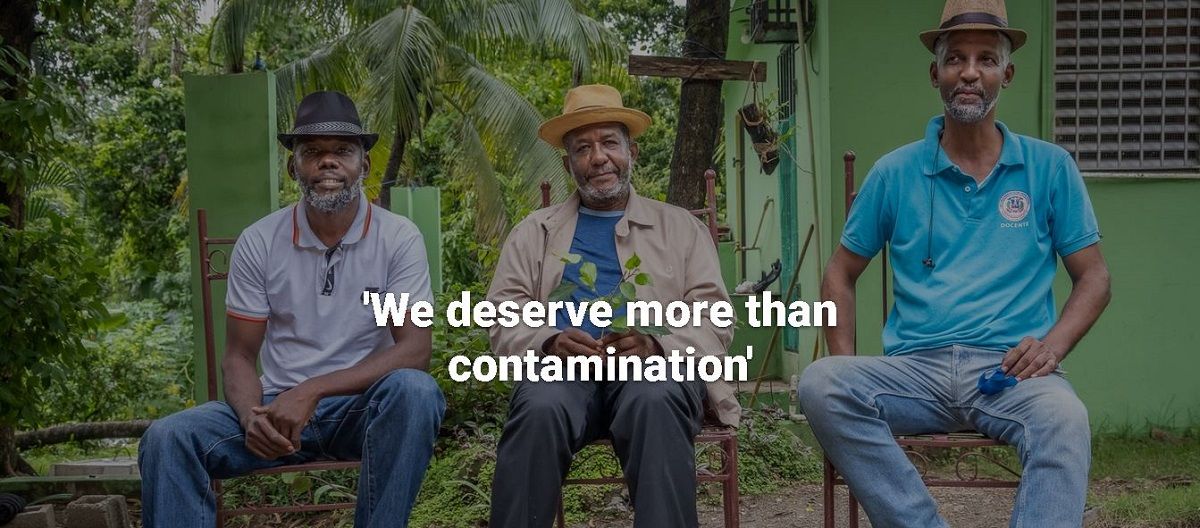 Mariano German De La Cruz, Segundo Maldonado Abreu, and Victor Alonzo
believe that by teaching their own people and others how special Haina's
residents are, no one can accept all the "waste being dumped on us”
Mariano German De La Cruz, Segundo Maldonado Abreu, and Victor Alonzo
believe that by teaching their own people and others how special Haina's
residents are, no one can accept all the "waste being dumped on us”
A first step is getting residents to understand that the contamination they live in is not normal and helping them to respect the environment and build a connection with it.
“Children grow up with this trash and contamination all around them,” says Victor Alonzo, a principal at a local school and another transformer. “And they will never find positivity in this contamination.”
Alonzo has started campaigns at his school to teach children to throw their rubbish away in a dustbin, rather than on the ground, and has led expeditions to clean up trash scattered on beaches in Haina.
“When we learn to respect the environment, then we’re learning to respect ourselves,” he says.
The transformers believe that young peoples’ knowledge of their culture and history, while developing an attachment to the environment, will lead them out of a life defined by contamination.
“We’re bringing the knowledge to the people through their own origins to wake them up so they can see what is happening around them and realise they deserve better,” De La Cruz says.
“It’s a business strategy to make it seem like Haina is only the industrial zone and contamination,” Abreu says. “Haina’s people and culture are much more valuable than these factories.”
Casa de La Cultura, created in 2007, has since 2014 been teaching the youth about various cultures in the country. “All of the Dominican Republic’s cultures exist here in Haina. We are one of the most important places in the country to teach about culture,” says Abreu.
Cultural knowledge could challenge peoples’ dependence on toxic factories and attract tourists and even bring income to the impoverished communities, transformers say.
“When we show and celebrate our culture then we can show the entire world that we deserve more than contamination,” Abreu explains.
And once the world realises how special the people and culture of Haina are, he says, “then no one could accept all this trash and waste being dumped on us.”











